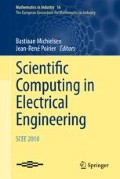Abstract
A boundary conformal technique for solving three dimensional electro-quasistatic problems with a high order Discontinuous Galerkin method on Cartesian grids is proposed. The method is based on a cut-cell approach which is applied only on elements intersected by curved material boundaries. A particular numerical quadrature technique is applied which allows for an accurate integration of the finite element operators taking into account the exact geometry of the cut-cells. Two numerical examples are presented which demonstrate the optimal convergence rate of the method for arbitrary geometry.
Access this chapter
Tax calculation will be finalised at checkout
Purchases are for personal use only
Preview
Unable to display preview. Download preview PDF.
References
Thoma, P.: Zur numerischen Lösung der Maxwellschen Gleichungen im Zeitbereich. PhD Dissertation, TU Darmstadt (1997)
Dey, S., Mittra, R.: A locally conformal finite-difference time-domain (FDTD) algorithm modeling modeling three-dimensional perfectly conducting objects IEEE Microw. Guid. Wave Lett. 7, 273–275 (1997)
Arnold, D.N., Brezzi, F., Cockburn, B., Marini, D.: Unified analysis of discontinuous Galerkin methods for elliptic problems. SIAM J. Numer. Anal. 39, 1749–1779 (2002)
Schöberl, J., Zaglmayr, S.: High order Nedelec elements with local complete sequence properties. COMPEL 24, 374–384 (2005)
OpenCascade 4.0, Open-Source Toolkit for 3D modeling (2001). URL: http://www.opencascade.com
Scholler, C., et al.: Numerical simulation of thermally coupled electromagnetic fields and fluid flow. In: Proceedings of Computational Methods for Coupled Problems in Science and Engineering, Papadrakakis, M., Onate, E., Schreffler, B. (eds.) CIMNE, Barcelona (2005), Santorini, Greece, May 2005
Author information
Authors and Affiliations
Corresponding author
Editor information
Editors and Affiliations
Rights and permissions
Copyright information
© 2012 Springer-Verlag Berlin Heidelberg
About this chapter
Cite this chapter
Fröhlcke, A., Gjonaj, E., Weiland, T. (2012). A Boundary Conformal DG Approach for Electro-Quasistatics Problems. In: Michielsen, B., Poirier, JR. (eds) Scientific Computing in Electrical Engineering SCEE 2010. Mathematics in Industry(), vol 16. Springer, Berlin, Heidelberg. https://doi.org/10.1007/978-3-642-22453-9_17
Download citation
DOI: https://doi.org/10.1007/978-3-642-22453-9_17
Published:
Publisher Name: Springer, Berlin, Heidelberg
Print ISBN: 978-3-642-22452-2
Online ISBN: 978-3-642-22453-9
eBook Packages: Mathematics and StatisticsMathematics and Statistics (R0)

